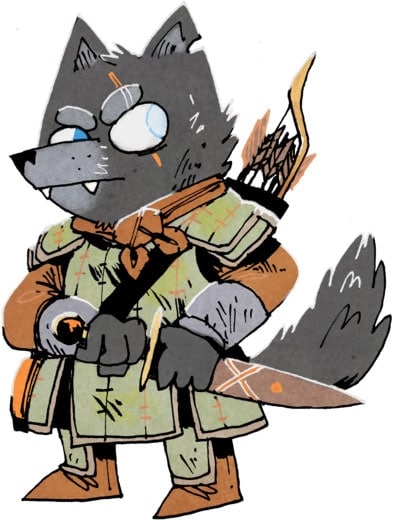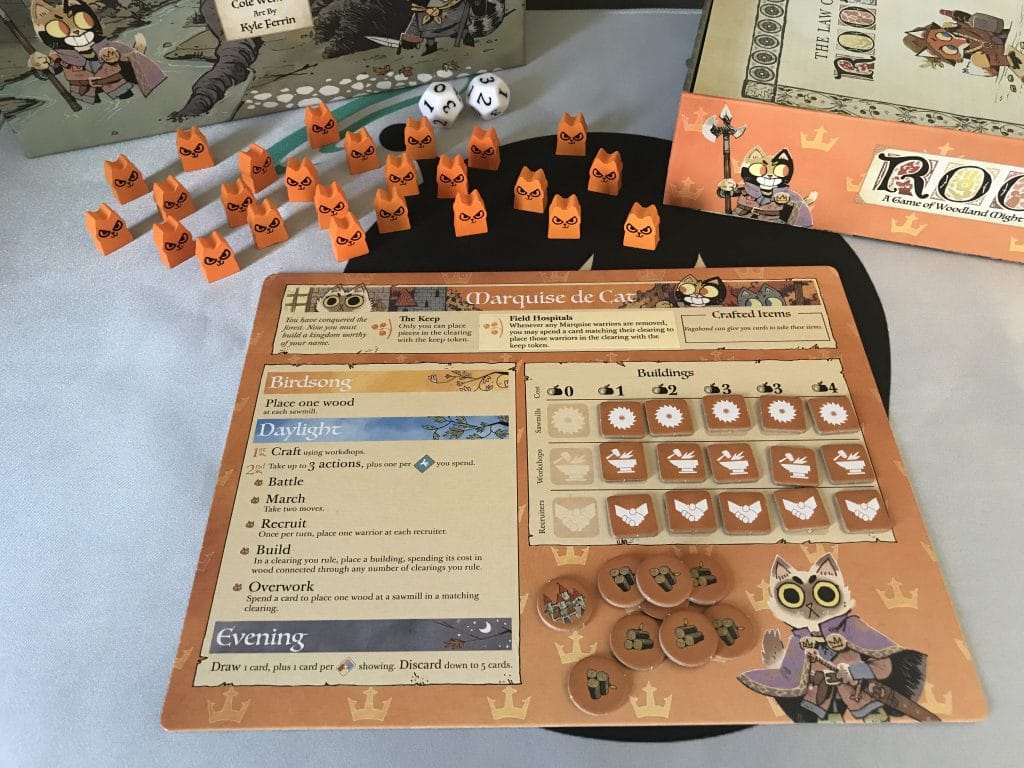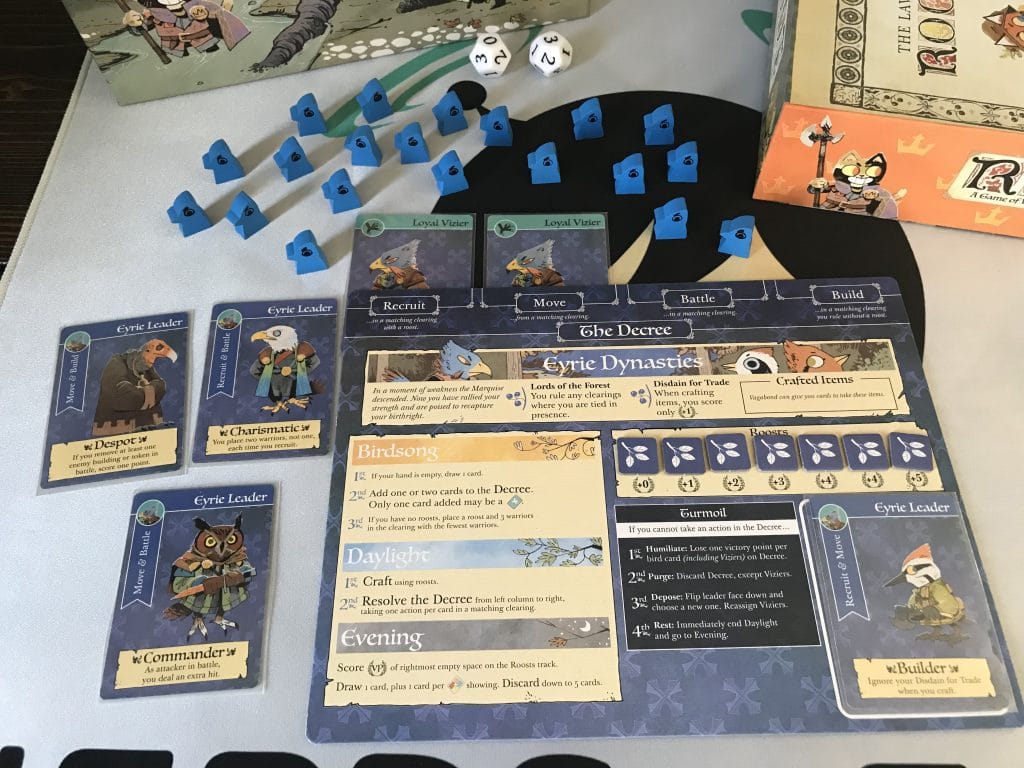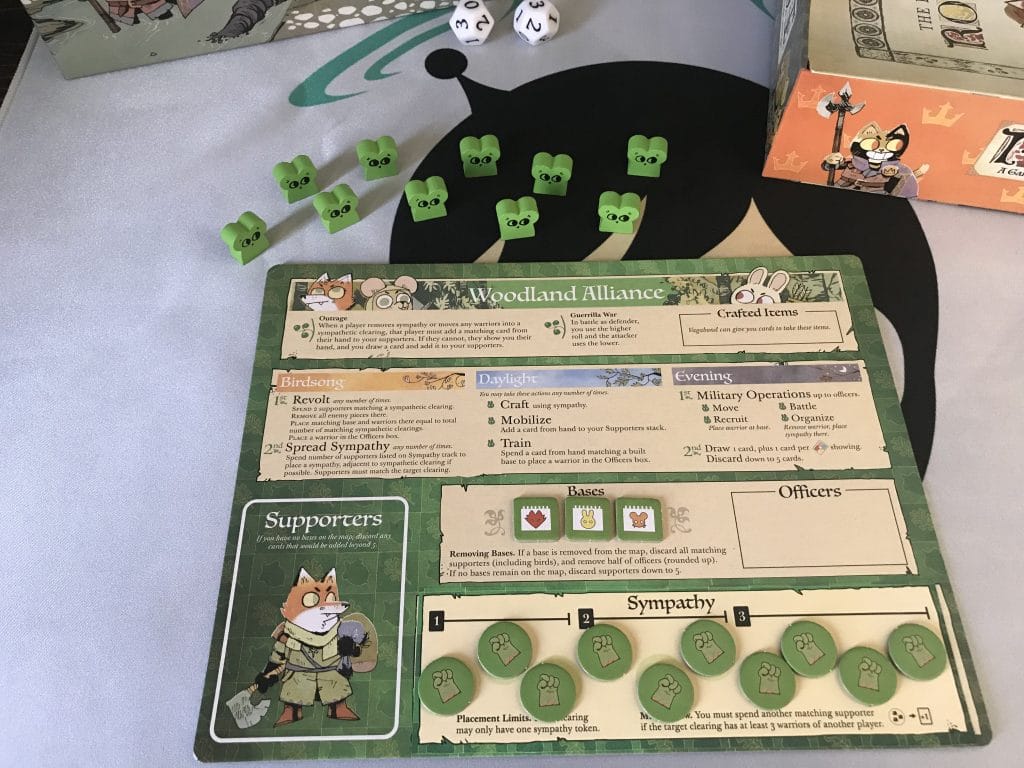Brian Jacques should get some honorary credit for raising me. His fantastic Redwall series was one of my favorites growing up, and I felt fully immersed in the world that he created. I wanted to nock arrows alongside the squirrels, forge weapons with the badgers, and, most importantly, partake in their absolutely ridiculous feasts.
Seriously, the food sounded AMAZING.
Sadly, you won’t find any candied chestnuts or Deeper ‘n Ever Turnip ‘n Tater ‘n Beetroot Pie in Root, a board game designed by Cole Wehrle and published by Leder Games. However, you will find gorgeous depictions of your favorite woodland critters, illustrated by Kyle Ferrin.
But don’t be fooled; the seat of powers in the forest is up for grabs and all of these animal factions are vying for the throne!
Root: Fight for the Forest
Despite what you might think, the forest isn’t a calm, serene place. A war wages beneath the canopy, with multiple factions pitting forces against each other to secure their foothold in the region:
- Marquise de Cat – The sprawling reach of the cats is earmarked with the fruits of their industrial labors.
- Eyrie Dynasty – Proud and strong, the Eyrie Dynasty wishes to return to the good ol’ days when they were the de facto leaders of the forest
- Woodland Alliance – Rumors of revolution flutter on the breeze as the Alliance gains traction to overthrow the main powers and gain sympathy from the people
- Vagabond – A lone wolf, the Vagabond will pledge his allegiance wherever it benefits him the most.
Root is an asymmetric wargame where each faction is completely different from the rest. They all have their own way of scoring, so it’s important that the players understand how each of them works before getting started.
Round by round, the players take turns performing actions during their Birdsong, Daylight, and Evening. This consists of crafting items, constructing buildings, recruiting warriors, battling other factions, and so on. In full games with four players, the map gets crowded quickly, meaning that the threat of combat is always present.
It’s a race to 30 points, which is going to come quicker than you might think. Points come slowly in the beginning of the game, but it definitely ramps up as the game progresses. The Eyrie and Marquise de Cat factions seem to plod along the most consistently, while the Vagabond and Woodland Alliance are able to burst for some huge point swings.
Everyone is always ‘in’ the game – don’t get too focused on the point track or you’re bound to be surprised by someone you’ve been neglecting!
Staking Our C.L.A.I.M on Root
Components

As mentioned earlier, the art by Kyle Ferrin is fantastic. From the board, to the faction mats, to the cards, everything in this game is visually stunning. I love the minimalist style of the warrior pawns – so much can be inferred about a faction just by the eyes!
The double-sided board offers two maps to play on (autumn and winter), although some of the boards refuse to sit flat which is a minor quibble. All of the other tokens, items, buildings, and victory point markers are made of thick, sturdy cardboard.
One thing I immediately did with my copy was sleeve up all the cards to protect them. The only problem with this is that the cards don’t fit well with the included box-insert, so if you’re thinking of doing the same thing, you’ll have to scrap it. Which is a shame, because it’s a wonderful insert.
Luck
Anytime dice are involved with a wargame, I immediately get skeptical. Leaving combat up to chance can lead to some incredible defensive stands and some agonizingly inept offensive pushes. Fortunately, Root handles this in an elegant way that ensures attackers are rewarded for their efforts.
Attackers roll two twelve-sided dice to determine how many hits are sustained by each side of the conflict. The higher dice usually goes to the attacker, except when the Woodland Alliance is involved. This means that at a bare minimum the attacker will be inflicting at least the same number of hits as the defender.
Apart from the dice, luck comes into play with card drawing. Cards are used to craft items and abilities. Depending on your draws, you might never be able to craft these cards, meaning that you’re missing out on valuable victory points and special abilities. I feel like there’s enough card draw to offset this, but it’s not something that should be overlooked.
Again, these are things that you deal with everytime players draw from a deck or roll dice. Since everyone is affected equally, luck definitely doesn’t overshadow skill and tactics.
Aesthetics
Okay, so I already touched on this in the Components section, but it’s worth repeating: the game is beautiful. It’s entirely cohesive in its presentation and I love it.
Basically, it’s like Kyle Ferrin took everything that I imagined about Redwall during my youth and transplanted it directly into this game. Each of the factions has their own personality, just like the animals of the Mossflower Woods. If only a patrolling troupe of hares could be released…
The Riverfolk Expansion introduces the Lizard Cult and the Riverfolk Company, and everything blends seamlessly together between base game and expansion.
If you’re looking for other games with this same art style, Kyle Ferrin also did the artwork for Vast: The Crystal Caverns, published by Leder Games.
Interest

With Root being a wargame, it’s not for everyone. Even though it might be wrapped up in a cute and cuddly package, this is a combat-driven game at its core. The asymmetry is a nice touch that prevents one strategy from working every single game. For example, one game might see the cats building a bunch of workshops and scoring primarily through crafting items. Others might see those same cats focusing on their military to quell any uprisings.
I would agree that there is a decent learning curve starting out, especially since there are so many faction-specific rules to learn. It can be daunting, to say the least. However, it is also because of the factions that gives Root a lot of replayability.
Not only does it play well with a full four-player complement, this game plays smoothly with three players, or even mano a mano. There are recommendations in the rules for which factions play better in these situations, so refer to that to curate your game accordingly.
Mood
The forest is full of anarchy. At least, that’s what I’ve gleaned after playing Root multiple times. It’s chaotic, unpredictable, and wild, and therefore fits in the traditional wargame mold.
Despite the mountain of beautiful art, this game could just as easily be set in space with different alien species. Because of this, the game doesn’t rely heavily on its theme to be successful. If you spend a lot of time absorbing the aesthetics, you’ll eventually be whisked away into a woodland reverie, but it’s not the most intuitive connection to make.
To take this one step further, make sure your group is in the mood for some direct conflict. This just comes with the wargame territory! Draw in your friends with the little bread slice mice of the Woodland Alliance and then surprise them when they find out it’s not all plum pudding and elderberry tarts.
Root: Barking Up the Right Tree
I first caught glimpse of Root at GenCon last year and I thought about it incessantly until I finally got my hands on a copy. Folks – the hype is real. For someone who doesn’t typically gravitate towards wargames, this is a welcomed addition to my gaming shelf.
Once you get over the initial learning stage, gameplay flows more naturally as players pit these wonderful critters against each other. I’m excited to come back to Root for many years to come. This definitely gets my seal of approval!
Speaking of – I wonder if there’s any chance of seals being introduced in an aquatic-themed expansion…





